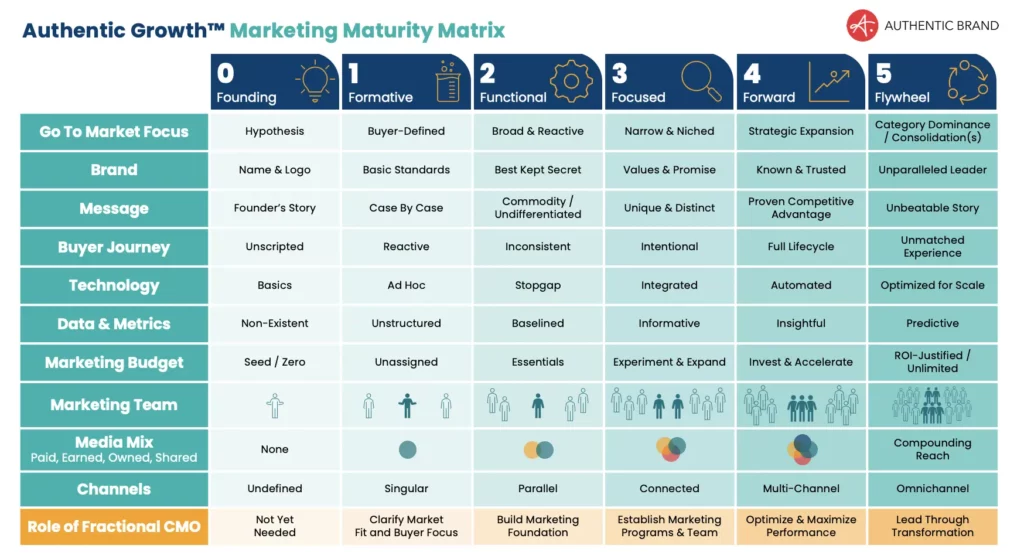
Focus is essential for scale
Regardless of their scale and pace of growth, growing businesses need to define and continually hone their go-to-market focus. This continued refinement enables a business to scale from a hopeful startup with a hypothesis to a category dominator that reinvents its space.
A go-to-market focus clarifies what a business brings to the world, why, and for whom. It includes the product or service the business offers, who its buyers are, and the market in which it will sell that product or service.
But narrowing in on the right market focus isn’t a simple undertaking. It requires discipline, focus, and time. At Authentic, we use our Authentic Growth® Marketing Maturity Matrix to show the stages of maturity a business must go through to solidify its go-to-market focus and ultimately own its category.

The path to category dominance: Stages 0 to 5
Solidifying a go-to-market focus starts with defining the owner’s or founder’s vision, exploring how to accomplish that vision through a particular market, and then moving through the stages of experimentation necessary to refine that focus. Once a business makes significant inroads with its market, it can expand outward again to find new markets to test and grow within. The following six stages demonstrate how a company moves through this progression.

Stage 0: Founding – Hypothesis
Every founder starts their business with an idea. This idea is a hypothesis that the founder can achieve something through an entity, whether solving a problem, providing a solution to a challenge, or addressing a particular market.
How to mature to the next stage: Answer critical questions that enable you to define your ownership vision — your “North Star.” These questions could include:
- Why are you in business?
- What do you ultimately hope to accomplish?
- What kind of value do you want to provide?
- Are you planning to be a freelancer/independent consultant, or do you want to build a company with employees?
- How will you fund the business?
- At what point do you want to exit the business, and under what conditions?
What you’ll need: A documented vision. This documented vision could be as simple as a journal or as organized as a business plan. Regardless, make sure you write down your vision, so you don’t lose sight of why you started in the first place, what you’re aiming for, and how you’ll know if you’re on track.

Stage 1: Formative – Buyer-defined
Eventually, your hypothesis will make contact with the market through prospect meetings, client engagements, and conversations with advisors in your network. This contact will invite all sorts of feedback and advice about what you should be doing or focusing on. Some of this advice can help refine your vision further, and some can be detracting.
Well-intended friends and clients will ask for your help in related or unrelated areas. (e.g., Could you help with this thing? Make this solution? Add some extra services for us?) When you need and want the work, you may be likely to take on whatever opportunities come your way. Experimenting at this stage is okay because it helps you further test your hypothesis and identify how to best focus it.
But it’s also a time when your vision can become clouded or redirected by others’ goals. Entrepreneurs can get so side-tracked that they build a totally different business than what they first imagined, which may not support their vision at all.
How to mature to the next stage: Make time for reflection. Take notes on what’s working and not working, what fuels your vision, and what detracts from it. Be conscious about what you say yes to, and decide in advance what you’ll say no to in order to preserve your energy for vision-aligned engagements.
When you agree to side projects, set clear expectations with clients about how you will or will not support their future needs. If you’re building a team, communicate openly and honestly about your vision and tell them if and why you’re taking on work that doesn’t align with it. Help the team (especially sales and marketing) stay focused on moving toward the original — or possibly evolving — North Star, even when that means fueling growth through some alternative engagements.
What you’ll need: Organized time and resources. Protect your calendar and capacity so you still have time to build your vision, refine your business plan, and make space to test your original hypothesis. Determine how much of your company’s resources you’ll reserve for this focus and how much you can divert to create revenue to fuel the vision.

Stage 2: Functional – Broad & reactive
As your hypothesis becomes a real offering, your company is likely still experimenting to find its ideal buyer and market fit. To experiment effectively, you will need to stay relatively broad and be open to responding to unexpected opportunities so that you can test various types of clients, industries, business models, channels, and partners.
You will need to establish a baseline of customer engagements and buying behaviors to know what type of buyer is the best, most profitable, and most aligned to support the organization’s vision.
How to mature to the next stage: Focus on data and metrics. Put systems and processes in place to measure each step of your sales process and pipeline and understand customer buying and retention dynamics. Over time, patterns will emerge that help you determine where your solutions are most valued and stickiest and produce the healthiest, most profitable growth for your business.
What you’ll need: Effective sales operations. Document your sales process and pipeline stages, use a CRM solution to capture all lead and customer engagement data, and build dashboards and reports that help you understand performance and patterns.

Stage 3: Focused – Narrow & niched
Perhaps you’ve heard it said before: If your business is trying to be all things to all people, you won’t be anything to anyone. Or, another phrase: there are riches in niches. Regardless of the phrase that sticks for you, any business that wants to compete, create value, and scale has to have a clear market fit and a unique offering. To do this, a business has to mature from broad baselining to decisive targeting.
This stage is often when businesses transition from being founder or sales-led (while often committing random acts of marketing) to investing in strategic marketing that supports growth.
How to mature to the next stage: Define your market fit based on insights from your baselined data and start directing your resources toward that specific type of buyer and marketplace. It can be a scary time in your business to narrow your focus and niche down. But, eventually, you have to choose a direction while also continuing to measure, test, and learn from it.
Choosing a narrowed focus doesn’t mean you have to say no to every outlier, but it does mean you target your ideal fit with everything you push out to the market. You have limited time, money and human energy, so it’s important to direct your resources wisely toward the healthiest, most ideal outcomes.
What you’ll need: Courage to take this next, critical step. This is a big step in business maturity, and it comes with the risk that your initial data or assumptions might not be perfect. Many founders and sales leaders struggle to make this leap because they’re afraid of losing revenue.
But most companies that shift to a tighter focus or niche (while continuing to measure and refine) will tell you that doing so has made them more profitable and more valuable to their buyers. You might choose to narrow your focus by industry, problem solved/use case, buyer role, region, or any combination of those criteria. Whatever you choose, that choice is never set in stone. You need to continue to test, measure, capture customer feedback, and be ready to pivot or innovate further as the market and buyer needs change.

Stage 4: Forward – Strategic expansion
Once you find a niche that enables you to scale and grow and establishes you as a strong player in that space, you’ve proven your market fit. (It’s important to recognize that this step alone can take several years.)
That baseline for success and growth now gives you a healthy foundation to consider strategic expansion through diversified offerings or new markets. You know that what you’ve been doing works, so it’s time to consider the next thing you can do to create additional business growth.
How to mature to the next stage: Think through your expansion opportunities while balancing risk. There are many options to consider when growing through diversification and each has risks associated with it. For example, you could bring an entirely new offering (feature, product, or service) to a new market (buyers who don’t know you already), but this is a high-risk option. Instead, you may consider bringing a new offering to an existing market or bringing an existing offering to a new market. Both of these options are lower risk than something entirely new to the business, and they’re also lower cost from a sales and marketing perspective.
What you’ll need: Outside expertise or advisors who are familiar with the space you’re targeting for expansion. For example, if you are a regional services firm that wants to expand nationally, you’d benefit by having guidance from others who have done the same. If you are a product company considering adding services for current clients, it’s important to fully understand the differences between a product and services organization. If you currently serve the construction industry and want to expand to finance or healthcare, you’ll want input from experts who understand those verticals and regulated industries.
And, of course, it’s helpful to do some research before you invest in any market or product development to test whether buyers value what you’re planning to provide and to learn about the competitive dynamics you might face in this new market.

Stage 5: Flywheel – Category dominance & consolidations
The flywheel stage, when your business dominates its category, is the holy grail. This is what almost every founder, owner, or leader wants to achieve eventually. Now, this doesn’t mean that your business has to become a global brand. Rather, category dominance is when your business is the leader in the specific niche you set out to own.
You could measure category dominance in numerous ways: a market analysis report, brand reputation study, client retention rates, and annual recurring revenue are a few examples. Whatever the measure, achieving category mastery and dominance is a true mark of organizational maturity. At this point, your business is likely being pursued by larger enterprises that see your company as a solid option for strategic acquisition. Or, perhaps you’re considering acquiring others in your ecosystem to further secure your foothold. This is also the stage when you can expect more direct hits from competitors and other market forces, as other businesses begin to recognize your threat to them.
How to continue maturing: This is not a time to get comfortable and rest on your accomplishments. Think about how any strategic integration with another offering changes your go-to-market focus. Your market may need to evolve as you expand capabilities, bring in new capabilities, or integrate brands. Return to the vision you crafted in stage 0, consider how it supports new stakeholders, and then re-articulate your vision so that everyone in the organization can align around it.
What you’ll need: An expert resource who can guide you through your next step, whether that’s someone experienced in mergers and acquisitions, private equity funding, or exit planning.
Dominate your category with a strong go-to-market focus
Defining your go-to-market focus, staying true to your narrowed niche, and measuring and refining the focus over time are no easy tasks. We created the Authentic Growth® Marketing Maturity Matrix to demonstrate how Authentic can support a company along its journey from a startup with a hypothesis to a category dominator.
Our fractional CMOs are experienced business leaders who have supported businesses through various stages of growth and maturity. Let’s connect if you’re ready to make strides toward category dominance with your go-to-market focus.









